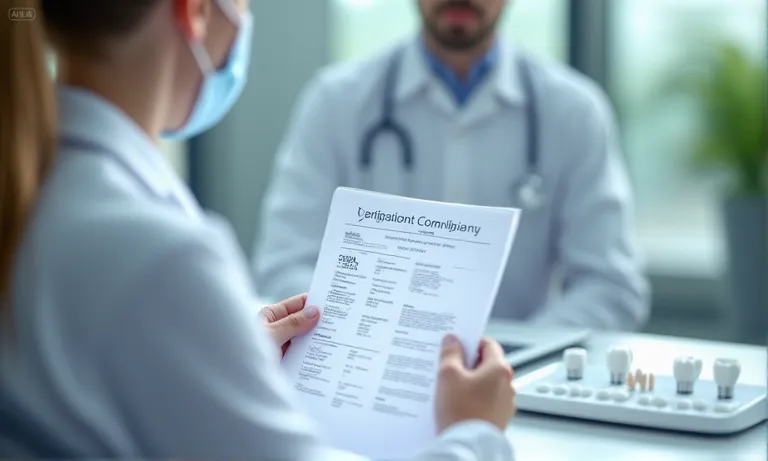Selecting and working with a new OEM dental implant lab partner requires more than comparing price—it depends on structured qualification, workflow alignment, and collaborative management. Evaluating certifications, technical expertise, and digital compatibility gives procurement teams a reliable basis for long-term cooperation.
Many buyers encounter challenges at this stage: unclear supplier credentials, inconsistent quality control, and misaligned digital workflows. These gaps often lead to delays, additional remake costs, and communication breakdowns during the early phase of cooperation.
The most effective way forward is to combine rigorous qualification checks—such as ISO and FDA compliance and financial stability—with clear setup agreements on scope, pricing, and turnaround. Running pilot projects provides measurable validation, while ongoing communication, shared trackers, and transparent feedback establish trust and predictability. Over time, this structured approach turns a new supplier relationship into a stable strategic partnership that supports both efficiency and clinical outcomes.
What Initial Qualification Checks Are Essential?
Choosing a new OEM dental implant lab requires a clear qualification process that looks beyond price. The essential checks focus on regulatory credentials, proven technical capabilities, quality control and traceability, and financial stability. Each factor gives purchasing teams a way to predict how a lab will perform under real-world pressures and whether it can support long-term implant partnerships.

dental-lab-quality-certification-check
Why are ISO 13485 and FDA registrations critical for dental implant labs?
ISO 13485 and FDA registration show that a dental implant lab follows internationally recognized manufacturing and quality system standards. These certifications ensure documented processes, validated equipment, and consistent product safety. For clinics and distributors, this reduces the risk of regulatory non-compliance when devices are imported or placed on the market.
- ISO 13485: Focused on medical device quality management systems.
- FDA registration: Required for legal entry into the U.S. market.
Together, they provide assurance that an overseas dental lab can produce implants that meet patient safety and legal requirements.
How to verify technical expertise and advanced implant manufacturing capability?
Technical expertise can be assessed by reviewing sample cases, digital workflow compatibility, and the lab’s use of advanced implant platforms such as CAD/CAM milling, custom abutments, and guided surgery kits.
- Ask for anonymized sample reports from previous implant cases.
- Review whether the lab supports multiple implant brands and systems.
- Check for investment in technologies such as 3Shape or Exocad design.
A global dental lab like Raytops dental lab often demonstrates its capability by sharing digital integration details and results from complex implant cases.
What quality control and material traceability procedures should be reviewed?
Strong labs maintain traceability for every lot of material and document inspection at each production stage. This prevents mix-ups and enables corrective action if an issue arises.
| Quality Check | Why It Matters | Example Practice |
|---|---|---|
| Incoming material testing | Prevents defects at the source | Verify zirconia batch certificates |
| In-process QC | Catches early errors before final milling | Random inspection per batch |
| Final inspection | Ensures consistent fit and finish | Digital measurement reports |
| Traceability system | Enables recall if necessary | Barcode or QR-coded work orders |
Why does financial stability matter for long-term supplier reliability?
A financially stable lab is less likely to cut corners on materials or delay deliveries due to cash flow issues. Clinics and DSOs benefit from suppliers that can weather demand fluctuations, invest in new technologies, and maintain consistent staffing. Verifying references, credit history, or years in operation helps ensure that a partnership will not be disrupted by sudden instability.
When procurement teams cover these four areas during qualification, they gain confidence that the lab is not only compliant on paper but also capable of sustainable support in daily operations. Working with an overseas dental lab that passes these checks means fewer disruptions, better predictability, and a foundation for trust in future collaboration.
How to Align Workflows and Expectations in the Setup Phase?
The setup phase is where successful implant lab partnerships are shaped. To avoid costly miscommunication, both sides must align on digital workflow compatibility, clear contractual terms, and data security expectations. This early alignment prevents disputes later and ensures smoother collaboration when complex implant cases arise.

dental-lab-contract-digital-workflow
Why is compatibility with digital files (STL, CAD/CAM) a key requirement?
Digital compatibility is the foundation of smooth workflows between clinics and labs. Misaligned file formats or outdated systems can cause delays or remakes.
- Confirm that the lab supports STL, DICOM, and major CAD/CAM platforms.
- Check whether their design systems (e.g., Exocad, 3Shape) integrate with your clinic’s equipment.
- Ensure they can handle large implant cases with multiple scans and merge files accurately.
A qualified overseas dental lab demonstrates file transfer protocols upfront and shares examples of successful digital integration with prior partners.
How should contracts define scope, pricing, and delivery expectations?
A clear contract avoids uncertainty and sets measurable expectations.
- Define scope: which implant systems, restoration types, and case volumes are included.
- Confirm pricing: unit price, add-on costs (custom abutments, rush cases), and shipping terms.
- Set delivery timelines: average turnaround for standard and complex cases.
- Clarify remake policies: conditions, timeframes, and cost responsibilities.
When scope and pricing are transparent, partners can plan confidently without hidden risks or unexpected costs.
What IT and data security protocols must be agreed upon?
Handling patient scans and treatment data requires trust. Labs should provide evidence of secure servers, encrypted transfers, and restricted staff access. Even if anonymized data is used, GDPR or HIPAA requirements may apply depending on jurisdiction. Reviewing how a lab manages backups, access logs, and breach response procedures ensures compliance and protects the clinic’s liability. Many global dental labs—including Raytops dental lab—routinely share their IT protocols with partners during onboarding to build confidence.
When both workflow mechanics and business expectations are aligned at the beginning, clinics avoid friction later in production. This early diligence turns the setup phase into a predictable partnership stage, where both sides know what to expect and how to deliver consistently.
What Pilot Projects Help Validate a New Lab Partner?
Pilot projects are the safest way to confirm whether a new OEM dental implant lab can deliver on its promises. By testing trial implant cases, monitoring remake rates, and benchmarking delivery performance, clinics and DSOs gain measurable evidence of the lab’s real-world reliability. These short-term evaluations reduce uncertainty before committing to large-scale cooperation.

dental-lab-trial-implant-case-review
How do trial implant cases reveal lab consistency and accuracy?
Running trial implant cases allows clinics to see if a lab can consistently reproduce precision across multiple restorations. Even small deviations in margin fit, screw channels, or occlusal contacts can affect patient outcomes. Reviewing 3–5 sample cases provides a clearer picture of how the lab handles complexity, especially when multiple implant systems are involved. A global dental lab like Raytops dental lab often treats trial cases as a “live audition,” where results show not only technical capability but also responsiveness to feedback.
Why are remake rates and adjustment needs critical validation indicators?
Remake rates are one of the strongest indicators of implant lab reliability. A lab that frequently requires chairside adjustments creates hidden costs and disrupts clinic schedules. Tracking both remake frequency and adjustment severity during pilot cases gives procurement teams quantifiable benchmarks.
| Indicator | Why It Matters | Pilot Target |
|---|---|---|
| Remake rate | Shows accuracy of design and milling | <5% during pilot phase |
| Chairside adjustment time | Reflects how well restorations fit | <10 minutes per case |
| Feedback turnaround | Measures lab’s willingness to improve | <48 hours response |
Low remake rates and responsive feedback loops build confidence that the lab can scale production without sacrificing quality.
How can delivery performance be benchmarked during the pilot?
Delivery speed is as important as technical accuracy. Clinics should test whether the lab meets agreed lead times for both standard and rush cases.
- Compare promised turnaround with actual delivery times.
- Track delays across at least 5 pilot cases.
- Confirm consistency across shipping methods and customs clearance.
A lab that reliably meets deadlines during the pilot is more likely to sustain predictable performance in long-term cooperation.
Pilot projects provide more than technical proof—they demonstrate how a lab communicates, solves problems, and handles logistics under real conditions. When clinics use structured benchmarks, they can quickly identify whether a potential partner is ready for scale or needs further improvement before entering a long-term contract.
How Should Ongoing Collaboration Be Structured?
Strong partnerships with an OEM dental implant lab depend on structured collaboration. Once initial qualifications and pilot projects are complete, long-term success comes from maintaining clear communication, using shared tools to manage complex cases, and fostering a culture of mutual respect. A lab relationship built on these practices avoids misunderstandings and supports predictable outcomes for both clinics and patients.

dental-lab-collaboration-meeting
What communication channels ensure smooth case management?
Clear communication reduces costly delays and misinterpretations. Clinics and labs should agree on:
- A primary point of contact for day-to-day case questions.
- A dedicated email or case portal for file transfers and updates.
- Instant messaging or video calls for urgent issues.
When labs and clinics define channels early, cases flow more smoothly, and urgent implant adjustments are handled without confusion.
How to use shared trackers and regular check-ins for complex cases?
Complex implant cases benefit from structured tracking and scheduled reviews.
- Set up a shared tracker (spreadsheet or case management software).
- List each case with milestones: scan received, design approved, milling completed, shipment dispatched.
- Hold weekly or bi-weekly check-ins to review progress and solve bottlenecks.
- Document changes and next steps directly in the tracker for accountability.
Labs like Raytops dental lab often provide pre-built tracker templates during onboarding, which reduces setup time and ensures clinics have visibility into every production step.
Why mutual respect and transparent feedback strengthen partnerships?
Beyond processes and tools, collaboration relies on trust. When clinics provide constructive feedback and labs respond transparently, both sides can continuously improve. A respectful tone matters when addressing remakes, delays, or design revisions—it turns potential conflict into problem-solving. Over time, these transparent exchanges create a partnership where each side feels valued rather than blamed, leading to more stable cooperation.
When structured communication, shared tracking, and transparent feedback all come together, OEM implant lab partnerships evolve from transactional to strategic. This structure not only stabilizes operations but also creates space for innovation and growth on both sides.
What Risk Management Practices Support Long-Term Success?
Risk management is what keeps long-term lab partnerships stable, especially when market conditions or supply chains change unexpectedly. By building contingency plans, diversifying materials and suppliers, and running continuous audits and training, clinics and labs protect themselves from disruption while maintaining compliance and patient safety.

dental-lab-risk-management-supply-chain
How to build contingency plans for supply chain disruptions?
Every lab partnership should anticipate possible breakdowns in logistics. Creating a contingency plan ensures business continuity:
- Identify critical materials and implant components that are most exposed to delays.
- Map out alternative shipping routes and logistics partners.
- Define stock levels or buffer inventory to cover urgent cases.
- Assign responsibilities so that each disruption triggers a clear response.
A well-prepared overseas dental lab often shares its contingency framework with partners, so clinics know exactly how delays will be handled before they occur.
Why diversifying materials and suppliers mitigates dependency risks?
Relying on a single zirconia vendor or one implant component source can create vulnerabilities. Diversification reduces this exposure.
- Maintain relationships with at least two qualified material vendors.
- Validate equivalent products across different suppliers to ensure flexibility.
- Balance local and international sourcing to handle customs or regional disruptions.
Diversification helps clinics and labs avoid production stops if one supplier faces shortages or regulatory changes.
How can continuous audits and training maintain compliance?
Compliance is not a one-time check but an ongoing process. Regular audits catch small issues before they become regulatory problems. At the same time, training keeps technicians updated on new materials, equipment, and documentation standards. Well-run labs combine internal audits with external certification renewals, and they invite partners to review protocols. Raytops dental lab, for example, integrates periodic compliance reviews into its client check-ins, which reassures procurement teams that quality is consistently upheld.
When labs and clinics treat risk management as a shared responsibility, they create stronger resilience against global uncertainties. Proactive planning, diversified sourcing, and continuous compliance practices transform potential risks into manageable challenges, ensuring stability for long-term implant partnerships.
Conclusion
Qualifying and working with a new OEM dental implant lab is not just about finding capacity—it is about securing reliability for years to come. By checking certifications, aligning workflows, validating through pilot cases, structuring collaboration, and embedding risk management practices, clinics and DSOs create a partnership model that supports predictable outcomes and patient safety. For decision-makers, the value lies in reducing hidden costs and avoiding disruption. When both sides treat quality, communication, and resilience as shared priorities, cooperation becomes sustainable. Partnering with an overseas dental lab that understands these dynamics ensures that every implant case is backed by consistency, compliance, and long-term trust.


